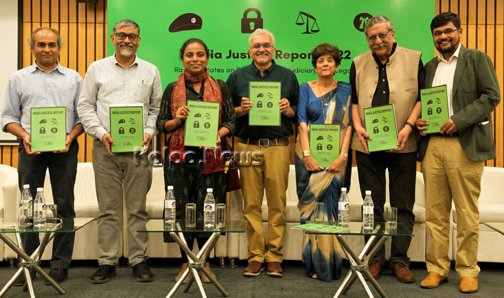Kalpa Media House | Bengaluru |
The 2022 India Justice Report (IJR), India’s only ranking of states on delivery of Justice in the country, announced here today, ranks Karnataka at the top of the 18 Large and Mid-sized states (with population of over one crore each), followed by Tamil Nadu (2020: 2nd), Telangana (2020: 3rd) Gujarat (2020: 6th) and Andhra Pradesh (2020: 12th). The list of seven Small States (population less than one crore each) was topped by Sikkim (2020: 2nd), followed by Arunachal Pradesh (2020: 5th) and Tripura (2020: 1st).
The India Justice Report (IJR) was initiated by Tata Trusts in 2019, and this is the third edition. Partners include Centre for Social Justice, Common Cause, Commonwealth Human Rights Initiative, DAKSH, TISS–Prayas, Vidhi Centre for Legal Policy and How India Lives, IJR’s data partner.
Through a rigorous 24-month quantitative research, the IJR 2022, like the previous two, has tracked the performance of states in capacitating their Justice delivery structures to effectively deliver mandated services. Based on latest official statistics, from authoritative government sources, it brings together otherwise siloed data on the four pillars of Justice delivery – Police, Judiciary, Prisons, and Legal Aid. Each pillar was analysed through the prism of budgets, human resources, workload, diversity, infrastructure, and trends (intention to improve over a five-year period), against the state’s own declared standards and benchmarks. This third IJR also separately assesses the capacity of the 25 State Human Rights Commissions (see SHRC brief for more).
The ranking of the 18 large-and mid-sized states is:
| States | Rank 2022 | Rank 2020 |
| Karnataka | 1 | 14 |
| Tamil Nadu | 2 | 2 |
| Telangana | 3 | 3 |
| Gujarat | 4 | 6 |
| Andhra Pradesh | 5 | 12 |
| Kerala | 6 | 5 |
| Jharkhand | 7 | 8 |
| Madhya Pradesh | 8 | 16 |
| Chhattisgarh | 9 | 7 |
| Odisha | 10 | 4 |
| Maharashtra | 11 | 11 |
| Punjab | 12 | 1 |
| Haryana | 13 | 9 |
| Uttarakhand | 14 | 15 |
| Rajasthan | 15 | 10 |
| Bihar | 16 | 13 |
| West Bengal | 17 | 17 |
| Uttar Pradesh | 18 | 18 |
The ranking of the seven small states is:
| States | Rank 2022 | Rank 2020 |
| Sikkim | 1 | 2 |
| Arunachal Pradesh | 2 | 5 |
| Tripura | 3 | 1 |
| Meghalaya | 4 | 7 |
| Mizoram | 5 | 6 |
| Himachal Pradesh | 6 | 4 |
| Goa | 7 | 3 |
Encouraging improvements, but persistent lacunae
IJR 2022, as in the first two, highlights persistent lacunae when aggregated for an all-India picture.
Vacancy is an issue across the Police, Prison staff, Legal Aid, and the Judiciary.
For 1.4 billion people, India has about 20,076 judges with about 22% sanctioned posts vacant. Vacancy among High Court judges is at 30%. As of December 2022, India had 19 judges per million population when calculated against the sanctioned strength, and a backlog of 4.8 crore cases. The Law Commission had desired, as early as 1987, it should be 50 judges per million in a decade’s time from then.
In the Police, women are only about 11.75%, despite their numbers doubling in the last decade. About 29% of the officer positions are vacant. The police to population ratio is 152.8 per lakh. The international standard is 222.
Prisons are over-occupied at over 130%. More than two-thirds of the prisoners (77.1%) are awaiting the completion of investigation or trial.
Most states have not fully utilised funds given to them by the Centre. Their own increase in spending on the Police, Prisons, and Judiciary has not kept pace with overall increase in state expenditure.
The justice system as a whole remains affected by low budgets. Except for two union territories, Delhi and Chandigarh, no state spends more than 1 per cent of its total annual expenditure on the judiciary.
India’s per capita spend on free Legal Aid —which 80% of the population is eligible for – is a meagre Rs 3.87 per annum.
Commenting on the India Justice Report, Justice (retd.) Madan B. Lokur, said, “The third IJR shows that states are making a substantive improvement over the last two ones in terms of adding new dimensions on diversity, training, and infrastructure. Some states have dramatically improved their performance but there is a lot that needs to be done on the whole. So far as the police is concerned there does appear to be a shortage of women officers in police. Legal aid is doing better but still a lot of people need to be provided quality free legal aid, we need to increase the confidence that people have in our services.”
Ms. Maja Daruwala, Chief Editor, India Justice Report 2022 points out, “As a member of the comity of nations and more importantly as a commitment to itself, India has promised that by 2030 it will have ensured access to justice for all and built effective, accountable, and inclusive institutions at all levels. But the official statistics brought together in the IJR this year show that we have a long way to go yet. I would again urge that the provision of affordable efficient and accessible justice services to each one of us be treated as necessary as food, education, or health. For this to happen more resources need to be ploughed into it, much more capacity built and much more attention paid to curing long standing deficiencies.”.
Contact For News & Advertisement: Whatsapp: 9008761663, 9481252093 – info@kalpa.news











Discussion about this post